The history of the city of Paris, the capital of France since the 10th century, is inextricably linked to the history of France. Throughout all times and to this day, Paris has been at the heart of the political, economic and artistic life of France. The tracks and traces of that importance are visible throughout the majestic monuments, buildings, squares and avenues of the city of Paris
The history of Paris dates back more than 2,000 years, to the middle of the Third century BC, when the Celtic tribe of the Parisii settled on the banks of the river Seine in ancient Gaul. The fortified village they established was described by Julius Cesar as an oppidum (a large fortified Iron Age settlement) surrounded by rivers. The name of the city – Paris – was inspired by these first inhabitants. Following the Gallo-Roman wars, the Roman Empire expanded to the Paris region and the Romans founded the city of Lutetia.
Nowadays, the Roman baths (thermae) and amphitheatre are still among the city’s historical landmarks. The history of the city of Paris, the capital of France since the 10th century, is inextricably linked to the history of France: at the end of the 5th century, Clovis I, the first king of the Franks, united all Frankish tribes under his leadership and is therefore considered the first king of what would become France. Despite being born pagan, Clovis embraced Christianity. With his baptism in the city of Reims, he laid the cornerstone to the edifice that would become the future French kingdom, considered a beacon of European Christendom in the Middle Ages. And all French kings would later be crowned in Reims.
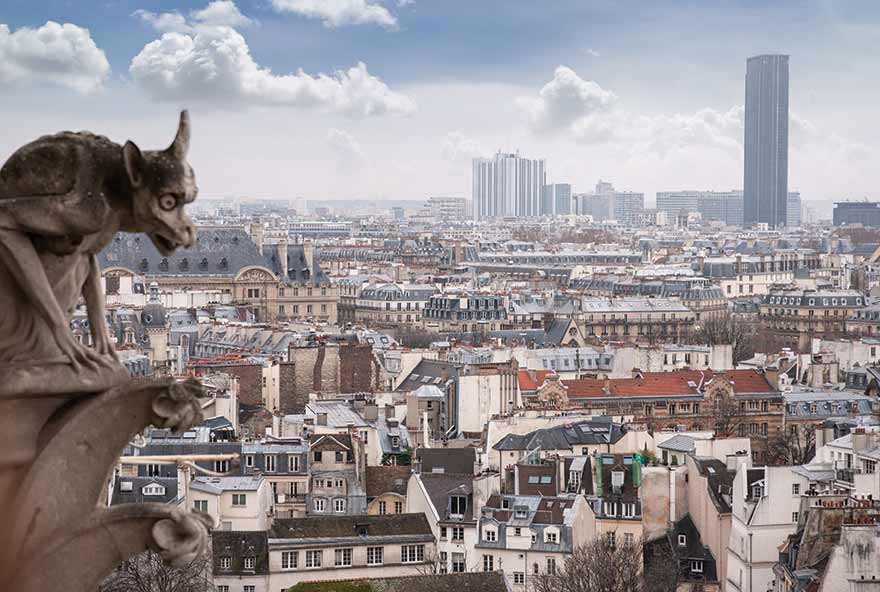
The coronation ceremony itself bestowed on them the divine mission of ruling over the French people. The belief that kings served God’s will on Earth gave them immense power. This regal power reached its peak in the absolute monarchy of Louis XIV and his heirs. And that absolutism ended with the French Revolution of 1789, but until 1870, when France became a Republic, the political centre of different regimes was always maintained in Paris. It was in the 10th century that the kings of France choose Paris as their capital and the site of royal residence – first on the City Island, later at the Louvre, and finally at the Palace of Versailles, constructed at the behest of Louis XIV.
The power of the kings of France and the domination of the church – later the First Empire, the July Monarchy, the Second Empire and the French Republic – have shaped the layout and development of the city. Throughout all times and to this day, Paris has been at the heart of the political, economic and artistic life of France. The tracks and traces of that importance are visible throughout the majestic monuments, buildings, squares and avenues of the city of Paris.
The cradle of Paris lies on the City Island, Île de la Cité, which is considered the centre of the power of the whole country. The Royal Palace was built on the west of the island, with Notre-Dame Cathedral erected on its eastern side in the 12th and 13th centuries. The monuments of that era can be considered eternal buildings
MEDIEVAL MONUMENTS
Following the collapse of the Western Roman Empire (476AD) and the emergence of Christianity, the city of Paris became the heart of the king’s dominion. The city spread westwards from the east. The cradle of Paris lies on the City Island, Île de la Cité, which is considered the centre of the power of the whole country. The Royal Palace was built on the west of the island, with Notre-Dame Cathedral erected on its eastern side. The left bank housed Sorbonne University, in the middle of the Latin Quarter, and many monasteries. The right bank was the location of the proper borough, with the city hall, harbour and market.
The monuments of that era can be considered eternal buildings – Notre-Dame Cathedral, built in the 12th and 13th centuries, remains standing to this day as one of Christianity’s pre-eminent houses of worship, with an emotional charge equal to that of Saint Peter’s Basilica in Rome. The greatness of the former French kingdom is represented by the royal chapel Sainte-Chapelle, which is said to have housed Christ’s crown of thorns until the French Revolution, which is now part of the treasury of Notre-Dame, and the Conciergerie building, which bore witness to the political centralisation of the Middle Ages.
The spirit of medieval times is still partly preserved and can be discovered by strolling around on City Island and the Latin Quarter. In the Latin Quarter, the 5th arrondissement, you can enjoy the small, narrow streets and old, single-storey houses that were once the centre of craftsmen and guilds, and home to the students of the Sorbonne.
ABSOLUTISM (17TH & 18TH CENTURIES)
Parisian architecture evolved during the reign of the Bourbon dynasty. Henri de Bourbon became king of France in 1689. Drawing inspiration from Rome’s imperial squares, he transformed the architecture of the French capital. Paris is a city that grew slowly and in concentric circles, with typically dark and narrow medieval streets. Henri IV established large squares in the middle of what was then a chaotic city. Those squares are named as Places Royales – Royal Squares. A royal square always has a geometrical form and is surrounded by unified architecture.
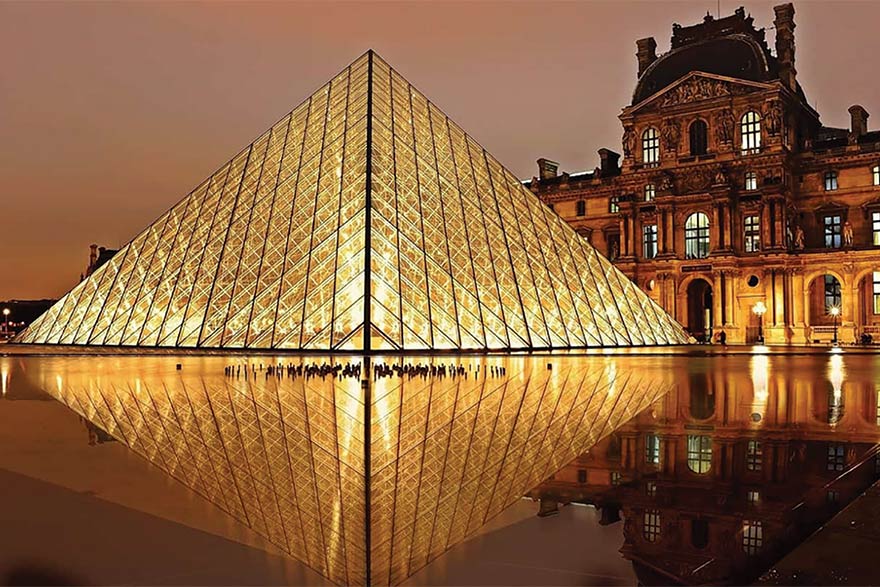
A royal statue is erected at the centre to glorify the king. These principles are maintained in all of Paris’s royal squares. The Place Dauphine, the first royal square, is located on City Island. Its triangular shape embraces the form of the island’s tip. The equestrian statue of Henri IV overlooks the square standing in the centre of the Pont Neuf, the New Bridge, which is the oldest standing stone bridge in Paris, built in 1607. The square is dedicated to the king’s son and heir, Louis XIII. The Place des Vosges also dates back to the time of Henri IV. Its 36 pavilions, with the pavilion of the queen and the king in the north and south, surround an open and sun-drenched square that is emphasised with and equestrian statue of Louis XIII at its centre. Louis XIV commissioned the Place Vendôme and the Place de la Victoire (Victory square), so he would be honoured by the population.
The Place de la Concorde (square of peace) was built under the reign of Louis XV and connects the right bank to the river and the historical axis of the Champs Élysées. With the construction of the royal squares, the kings of the House of Bourbon introduced the first wave of modernity, progress and values of architectural beauty in the city’s layout – as a precursor to the future architectural philosophy. The squares, dedicated to the greatness and majesty of the French God-given monarchy, are havens of beauty and light that were way ahead of their time.
THE SECOND EMPIRE AND THE THIRD REPUBLIC
The development of the city’s structure throughout the centuries is still visible today on the city’s map and in the structure of its urban planning: from the centre to the periphery, three concentric rings have shaped the street systems, which follow the lines of former city walls. The Grand Boulevards, former fortifications and city borders of the 14th century, built by King Charles V, shaped the contours of the first circle along the Opéra Garnier and the Arc de Triomphe of Louis XIV.
Parisian architecture evolved during the reign of the Bourbon dynasty. Henri de Bourbon became king of France in 1689. Drawing inspiration from Rome’s imperial squares, he transformed the architecture of the French capital
The second circle was shaped by the Wall of the Ferme Générale – General Farm (1784 – 1790), which authorised tax farmers to collect taxes for incoming goods. This wall limited the city’s extension until the rise of Napoleon III in the Second Empire. The Emperor decided to enlarge the city by annexing the surrounding villages to the capital and launched immense transformation works inside the then still medieval city centre. A large demolition and construction campaign was launched in the second half of the 19th century, giving Paris its modern face. Prefect Baron Haussmann, responsible for the reconstruction campaign, ordered the demolition of 20,000 old, often timber framed houses in the ancient quarter of Saint Germain des Près, the City Island, the Louvre and the Latin Quarter. Large, straight avenues were created, spreading in the form of a star from the centre to the city limits and creating the shape of a spider’s web. New, modern apartment buildings made of limestone were constructed; known as the Haussmannian Architecture – six storeys high and decorated with cast iron balconies, originally on the second and fourth floors. These balconies create a view of extending lines to a vanishing point at the end of the straight avenues. The avenues were bordered with trees in order to introduce greenery to the urban hub.
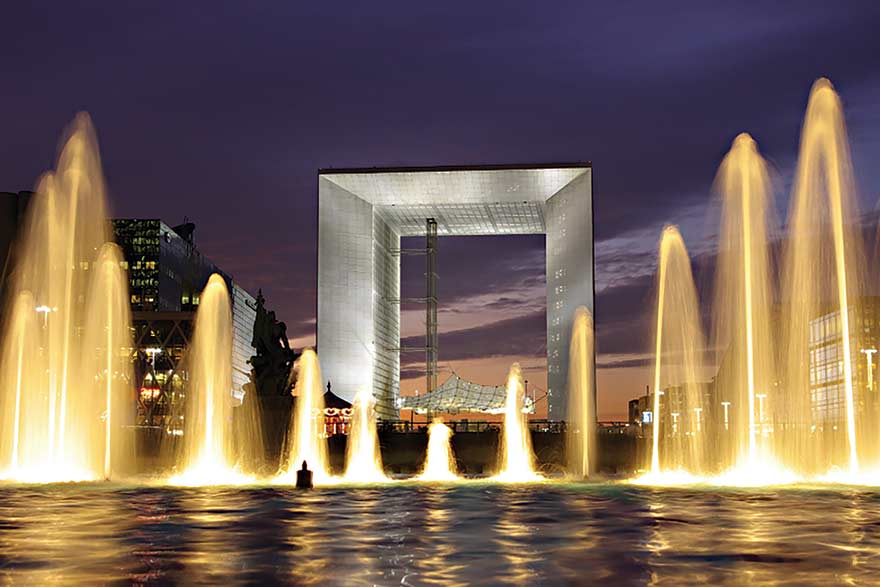
The layout was meant to emphasise beautiful and majestic perspectives, to filter the growing traffic and allow more light to enter the city. The most emblematic construction and masterpiece of this period is the Opera Garnier (1862 – 1875, Charles Garnier), positioned at the heart of the modern Paris of the Second Empire on the right bank of the city. Haussmann established a height limit of 37 metres on buildings in the inner arrondissements (districts) of Paris, which remains a rule of Parisian urbanism to this day. Some 40,000 Haussmannian building were constructed in the old city and the newly designed districts, raising the number of arrondissements from 12 to 20, and today 80 per cent of Paris’s building are still of Haussmannian architecture. Haussmann extended the city limits of Paris to the Thiers Wall, a fortification built during the July Monarchy (1841 – 1844) and demolished in 1919. These borders still represent the outer limits of Paris, doubled by the ring road highway around the city.
MODERN CONSTRUCTION
Due to the growing population of Paris, the Parisian administration is today considering the future enlargement of this metropolis – a project dubbed Grand Paris. Since the 1970s, modern architectural structures have been creating new landmarks in the city and beyond its borders. They are meant to create a link in time and space between the historical city and the modern, contemporary living space; they can be seen as a communicative dialogue between the past, the present and the future: The Centre Pompidou (1977, Renzo Piano, Richard Rogers, Gianfranco Franchini) was the first major project in this sense. The Piazza, a large square in front of the building, links the Centre Pompidou to the very dense surrounding quarter and invites visitors to rest and admire the colourful and transparent architecture of tubes and glass.
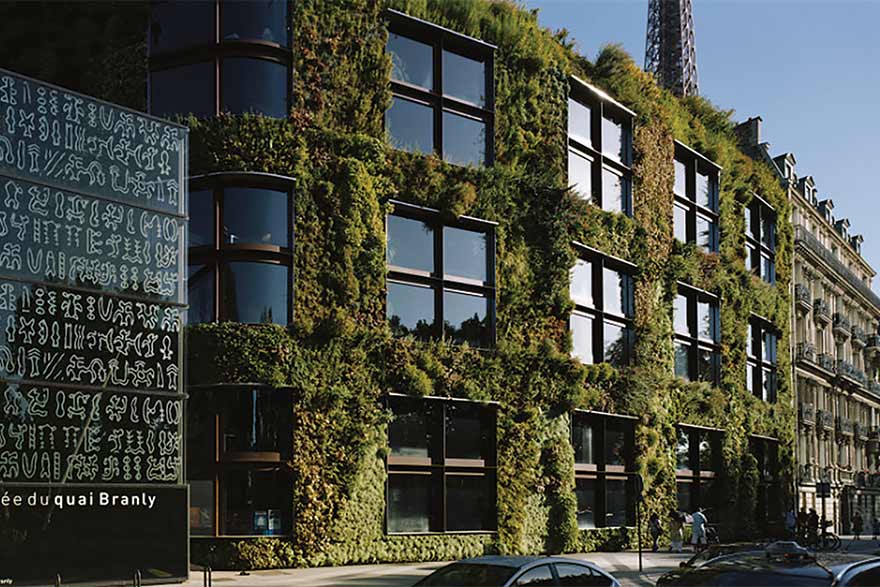
Monumental bays allow communication between the internal and the external, the traditional and the modern. Like many kings and emperors before him, former President François Mitterand commissioned outstanding new monuments to emphasise the progressive urban vision of Paris and in order to be remembered through them. At the time of its construction, the Pyramid of the Louvre (1989, Ieoh Ming Pei, Roger Nicolet) was a very sensitive matter to Parisians and provoked many controversial discussions. The pyramid was intended to modernise and embellish the classicist Palais du Louvre. The pyramid, composed of 673 glass panels held together by an iron structure, symbolises the eternal aspect of the Louvre and offers a new interpretation of the eternal pyramids of Giza.
The Grande Arche de la Défense (1989, Johan Otto von Spreckelsen, Paul Andreu, Peter Rice) at the heart of the city’s modern central business district of skyscrapers, extends the so-called historical axis desired by Louis XIV, the Sun King. It stands in the perspective of the Louvre, Concorde Square, the Champs Élysées and the Arc de Triomphe. A gate that opens Paris up to the world – intense, impressive and geometric – the Arche stands at the crossroads of communication and intercultural encounters, as the bearer of French and humanist values.
Louis XIV commissioned the Place Vendôme and the Place de la Victoire (Victory square), so he would be honoured by the population. The Place de la Concorde (square of peace) was built under the reign of Louis XV and connects the right bank to the river and the historical axis of the Champs Élysées
The Library François Mitterand (1995, Dominique Perrault) houses the National Library of France and has its origins and funds in the 14th century. An initiatory building, it is displayed like four open books at a 90° angle due to the high and transparent verticality of its glass walls. The project is a piece of Urban Art, a minimalist installation, where “less is more” in terms of emotion. As a reference in eastern Paris, it suits the continuity of the succession of great voids along the Seine, such as Concorde Square, the Champs de Mars and the esplanade of the Invalides. The Museum Quai Branly – Jacques Chirac (2006, Jean Nouvel) is an audacious building conceived as a showcase for the collections of non-European primary cultures.
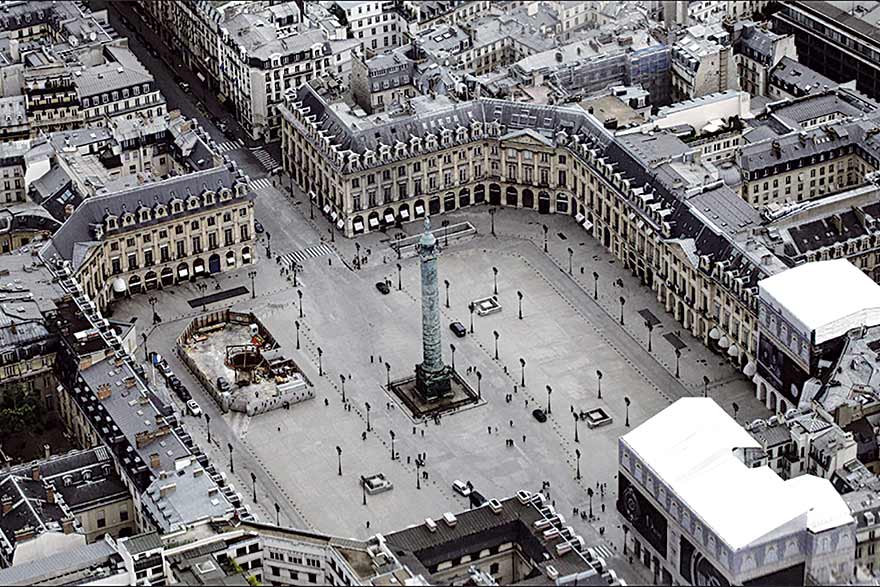
Jean Nouvel emancipated himself from the occidental architectural references to create a bridge between cultures. The result is a mysterious edifice composed of fluid curves. Multicoloured “boxes” seem to be suspended and encrusted in the façade, providing intimate spaces in the museum’s interior. The façade is protected by dense vegetation and a glass palisade, which the visitor must cross to discover the site and receive the invitation to a passionate journey. The Cité de la Mode et du Design – les Docks (2012, Jakob & Macfarlane) is an architectural transformation project of the former merchandise docks of Paris, built in 1907. The façade was transformed to create a glass construction of a bright, fluorescent green in wave form, combined with wood and iron. A carpet of grass on the roof reflects the colour of the building. The Boulogne Wood’s Louis Vuitton Foundation (2014, Frank Gehry) houses the Museum of Contemporary and Modern Art. This audacious and poetic construction offers a different approach to conventional architecture. This powerful structure plays with gravity, spreading volumes that defy the clouds. Innovative, the building provokes a visual rapture revisiting the idea of perspectives. With its narrative, the site invents a new futurist concept raising surprise and emotion.
The Canopy of Les Halles (2016, Patrick Berger, Jacques Anziutti), made of green-tinted iron and glass, draws its inspiration from the curves of vegitation. The canopy actually represents the upper part of forests in direct contact with the atmosphere and the rays of the sun. Since the demolition of the famous market halls of Baltard in 1970, the quarter of the medieval market has seen a lot of transformations, such as the disappearance of Pavilions Willerval, which was demolished to make way for the canopy. Paris was, and always will be, an inspiration for culture, art and architecture; a melting pot of progressive and innovative ideas guiding the metropolis towards the future.